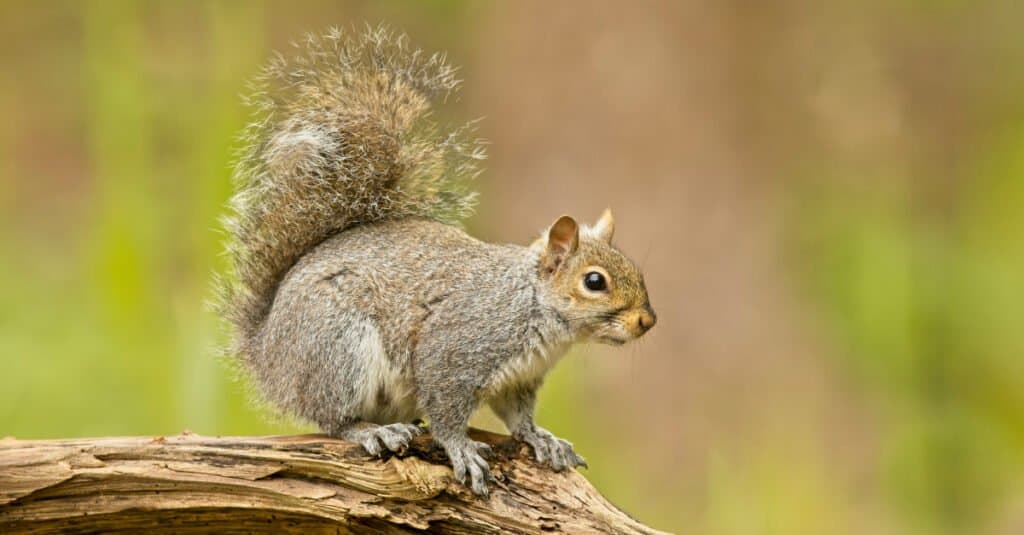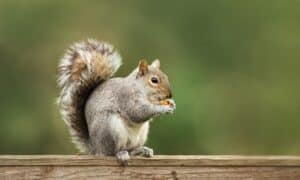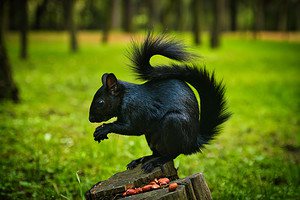A squirrel is a small rodent that belongs to the family Sciuridae. They are found in most parts of the world, including North America, Europe, Asia, and Africa. Squirrels prefer to live in wooded areas with plenty of trees and plants for food and shelter. Some species even make their homes in urban parks or gardens. Do squirrels have babies? Keep reading to learn more about this intelligent animal!
Do Squirrels Have Babies: Breeding and Gestation

Squirrels are typically born between March and April.
©Nilanka Sampath/Shutterstock.com
Foxes and squirrels begin reproducing when they reach one year old. Usually, the breeding season is during mid-December or early January, and a small portion reproduces once more during June. Young squirrels usually only mate once in their first year. The period of gestation for these creatures lasts between 42 to 45 days. According to The National Wildlife Federation, squirrels are typically born between March and April in litters of three to seven. If they have a second litter, that one will be born in July or August. The breeding season is later in colder climates, and babies can be born as late as May.
The reproduction habits of other squirrels native to North America are comparable to those of fox and gray squirrels. But, the majority of other species only mate once a year.
Male squirrels can smell when a female is ready to mate. This is due to the presence of certain pheromones released by the female during her estrus period. When these pheromones are present, it triggers a behavioral response in the male that tells him she’sshe’s ready for mating. The male will then display courtship behavior.
During the squirrel breeding season, males can be seen chasing females through the trees in loud mating chases. 1 or 2 males will pursue a single female for an extended period of time. The male squirrels may also compete with each other for access to the female as well. When successful in their pursuit, copulation between the two squirrels may last up to several hours. Their mating may also happen multiple times before moving on to find another mate.
Do Squirrels Have Babies: Birth and Litter Size
Tree squirrels usually have 3 or 4 young per litter, though the number can vary. Litters of up to 8 babies are possible but not common. At birth, they are blind, hairless, and their ears closed. Newborn squirrels weigh about ½ ounces; at five weeks old, they weigh around 3 to 4 ounces. By the time they are weaned at 10-12 weeks old, they will be roughly half of their adult weight.
Once a squirrel is weaned, it begins to explore. It will travel outside the nest and practice its newfound skills. These include climbing trees or digging in the dirt for food. In the wild, only 50% of tree squirrels typically survive each year, with an average lifespan of 4 years. However, those living in captivity may live up to 10 years. This is due to environmental factors like protection from predators or access to better resources such as food and shelter.
Birth Location

Squirrels rely on their sense of smell to find the caches in which they hoard their food.
©iStock.com/birdsonline
Where do squirrels give birth and raise their young? Typically, these animals prefer to live in hollow trees or human-made boxes. In the summer, it is not uncommon for them to build large, leafy nests to stay cool. However, cavities are still their preferred nesting spots. This is because they provide better protection and a higher chance of survival for the young.
The size of a squirrel’s territory varies from one to a hundred acres. This will depend on the time of year and food availability. Squirrels tend to migrate within their range in response to their food sources. They may travel up to fifty miles in autumn to find better habitats with more nuts and corn. The population of squirrels can rise and fall over time. In times of overpopulation, grey squirrels may participate in group migrations where many of them lose their lives.
Do Squirrels Have Babies?
Baby squirrels (kittens) are blind and deaf when they are born but begin to open their eyes after about three weeks. The mother will nurse the offspring until they reach 8-10 weeks old, at which time she will begin teaching them survival skills such as foraging for food and climbing trees. After five months or so, the family unit breaks up as the young squirrels become independent. During this process, it is important for humans to keep their distance from baby squirrels to avoid stressing out the mother or causing injury to any of the babies.
The newborn squirrels are unable to see or hear and must be fed every two to four hours for many weeks. At about seven to eight weeks of age, the young will start to accompany their mother outside the nest. They will begin to eat regular food and be weaned at ten to eleven weeks. Subsequently, they will start leaving the den permanently. If there are not too many squirrels around, the youngsters will create nests near the birthing den, sometimes in the same tree. They may be pushed away to quieter feeding sites if the area is overcrowded. Generally, some of the squirrels will remain in the area and reuse the birthing den if it is available.
A Scurry of Squirrels

Squirrels have dens and build nests in trees to store grains and nuts for food.
©Mircea Costina/Shutterstock.com
A group of squirrels is called a scurry. You don’tdon’t see them very often because squirrels are solitary animals who prefer to live alone. Seeing such a large gathering of these animals can be quite rare, as they are highly territorial and usually live on their own. Most scurries consist of mothers with their children. However, some may also include siblings or distant relatives who have come together to protect from predators or keep warm during a particularly cold winter. You might find more squirrels in groups during certain times of the year because the breeding season has begun, and more squirrels congregate to reproduce successfully.
Smarter Than We Thought
We all know that squirrels bury their food. But why? Squirrels bury their food for a variety of reasons. They may be trying to hide it from other animals or storing food for the winter months when food is scarce. Squirrels mainly eat nuts and seeds, but they also enjoy fruits and vegetables, as well as insects and even bird eggs. Depending on their location, squirrels can adapt to eating whatever is available to survive.
People can observe that squirrels are quite picky when it comes to where they store their nuts before the winter season. They often select a recognizable spot, like a big oak tree, to easily locate where they put the nuts. Several squirrels in the same area could have the same opinion, making it easier for them to find a stash of nuts.
Regarding intelligence, squirrels certainly have much more going on than meets the eye. They are known for their memory and problem-solving skills, which allow them to remember where they buried nuts or acorns and then retrieve them later. Not only that, but they can also crack open certain types of nuts before burying them so that they don’tdon’t germinate in the ground. When hunger strikes, these intelligent critters will dig through the earth to find their hidden treats.
At mealtimes, squirrels search for the nuts they have hidden away. They have a good sense of smell which helps them locate these snacks beneath the ground. Researchers have observed evidence of their intelligence in how they store food, such as in a study from 2008 which found that Eastern gray squirrels use a strategy called “deceptive caching” – they make a hole, pretend to put an acorn in, and then move away quickly to another spot, likely to prevent other squirrels from noticing. Tricky!
The photo featured at the top of this post is © Nilanka Sampath/Shutterstock.com
Thank you for reading! Have some feedback for us? Contact the AZ Animals editorial team.






